Several species of grouse inhabit my backyard (Wrangell/St. Elias National Park and Preserve), Alaska. Above, sharp-tailed grouse.
video link below: Grouse in my backyard

Several species of grouse inhabit my backyard (Wrangell/St. Elias National Park and Preserve), Alaska. Above, sharp-tailed grouse.
video link below: Grouse in my backyard
 A pair of gray jays have finished their nest by early April.
A pair of gray jays have finished their nest by early April.
I first saw the gray jays as they flew across the road in front of me. They both carried loads of building materials in their bills. The next day I went searching for their nest. It was rather easy to find as they were both busy with construction. The nest was about twenty feet high in a medium-sized black spruce. They had completed a loose bowl of dry spruce twigs and were currently engaged with stuffing this framework with insulation. The pair gathered black, grizzly hair lichens as well as spruce grouse feathers. But their most prized finds were the long soft plumes of the northern hawk owl. After delivering a load of insulation, the birds would hop into the nest and push with bills and feet as they rotated around in the nest, fitting and forming it to just the right shape. The female begins sitting on the nest and a week later her clutch of spotted eggs is complete. The pair is quiet at the nest site and does not attract attention of those nest raiders, magpies and ravens. When a red squirrel was spotted nearby it was dive-bombed by the male gray jay and driven away.
The female begins sitting on the nest and a week later her clutch of spotted eggs is complete. The pair is quiet at the nest site and does not attract attention of those nest raiders, magpies and ravens. When a red squirrel was spotted nearby it was dive-bombed by the male gray jay and driven away.
 For nearly three weeks the female incubated her four eggs. A few times a day she will leave the nest but only for a few minutes, perhaps to drink.
For nearly three weeks the female incubated her four eggs. A few times a day she will leave the nest but only for a few minutes, perhaps to drink.
 The male gray jay shows up at the nest about once an hour or so to feed his mate.
The male gray jay shows up at the nest about once an hour or so to feed his mate.
 Laying eggs is an energy drain and the female spends hours sleeping.
Laying eggs is an energy drain and the female spends hours sleeping.
 Early nesting grays jays must be able to handle cold, wet conditions in their Alaskan habitat.
Early nesting grays jays must be able to handle cold, wet conditions in their Alaskan habitat.
 Both adults help feed the quickly growing gray jay chicks. Gray jays store amazing amounts of food including carrion and I wondered if they would feed their cached supplies to their chicks. But Instead they foraged the ground for insects and larva, much better food for the new chicks.
Both adults help feed the quickly growing gray jay chicks. Gray jays store amazing amounts of food including carrion and I wondered if they would feed their cached supplies to their chicks. But Instead they foraged the ground for insects and larva, much better food for the new chicks.
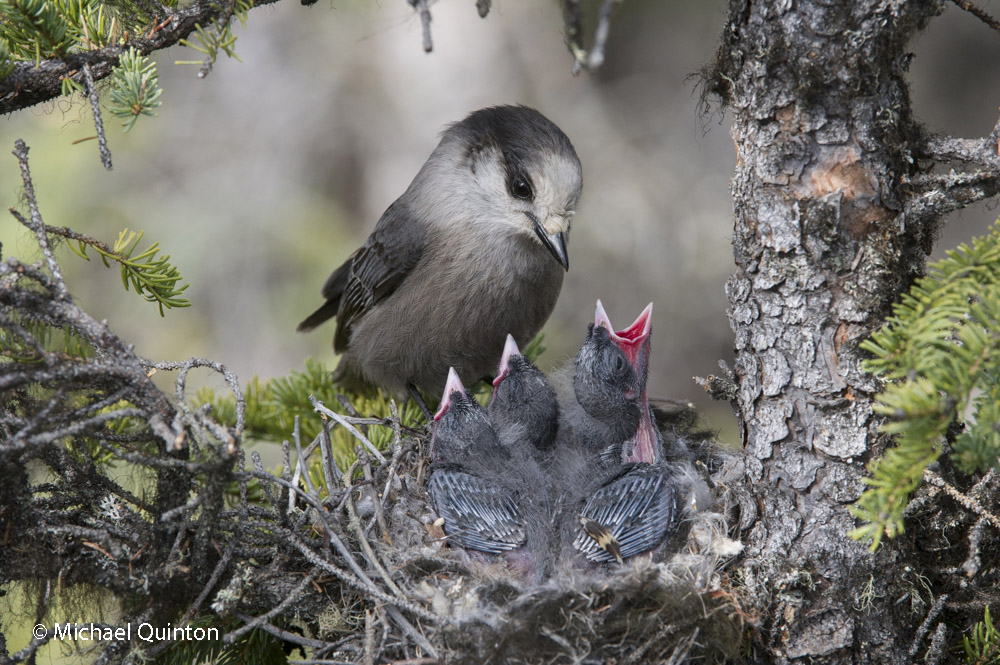 As the chicks grew the gray jays cached stores of carrion became more important. And it quickly became apparent that the nest would never hold four growing chicks for long. By the time the chicks were about two weeks old, they jostle for the best position at the nest. I witnessed deliberate attempts by the larger chicks to force their smaller siblings out. One morning there were just two chicks left in the nest. Below the nest on the ground were the missing chicks, both dead. From human eyes, a tragic event. But for nature, another one of those mysteries of survival.
As the chicks grew the gray jays cached stores of carrion became more important. And it quickly became apparent that the nest would never hold four growing chicks for long. By the time the chicks were about two weeks old, they jostle for the best position at the nest. I witnessed deliberate attempts by the larger chicks to force their smaller siblings out. One morning there were just two chicks left in the nest. Below the nest on the ground were the missing chicks, both dead. From human eyes, a tragic event. But for nature, another one of those mysteries of survival.
Come July of this year the name of the gray jay will change once again. They will officially be known as the Canada jay. And like camp robber and whiskey jack, gray jay will be just another nickname used to describe this gray-colored jay of the northern forests.
A pair of northern hawk owls check out the view from atop a prospective nesting cavity. Hawk owls, like other owls, do not build a nest but use natural cavities and bowled out snags. The male establishes a territory that includes potential nests sites, but it seems to be the female who makes the final choice of snags.
After settling on another snag, the female incubates her eggs. Hawk owls nest early, usually in late April and will endure winter conditions.
Check out my photo story about northern hawk owls in the May 2018 issue of RANGER RICK, Just click the link below.
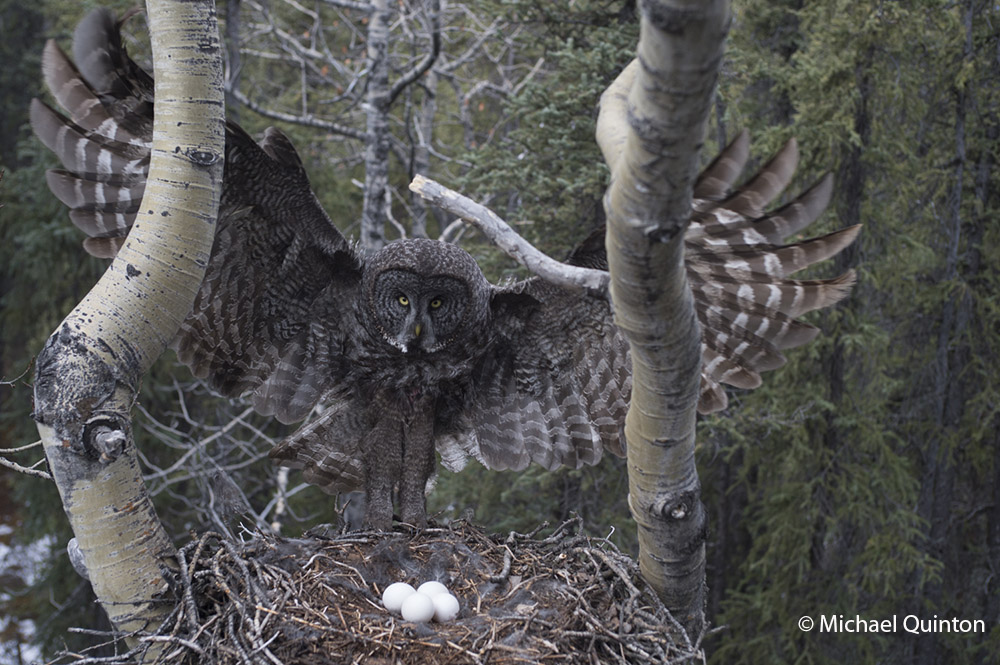 A female great gray owl spreads her wings as she gently lands on the edge of her nest to resume incubating her four eggs. For two months this nest is the nucleus of activity for a pair of great gray owls. Owls do not build their own nests. Instead they use a variety of ready-made and vacant nests, like this one built many years before by northern goshawks. The great grays I had photographed three decades ago in Idaho prefered the bowled out tops of large broken pine trees for their nests.
A female great gray owl spreads her wings as she gently lands on the edge of her nest to resume incubating her four eggs. For two months this nest is the nucleus of activity for a pair of great gray owls. Owls do not build their own nests. Instead they use a variety of ready-made and vacant nests, like this one built many years before by northern goshawks. The great grays I had photographed three decades ago in Idaho prefered the bowled out tops of large broken pine trees for their nests.
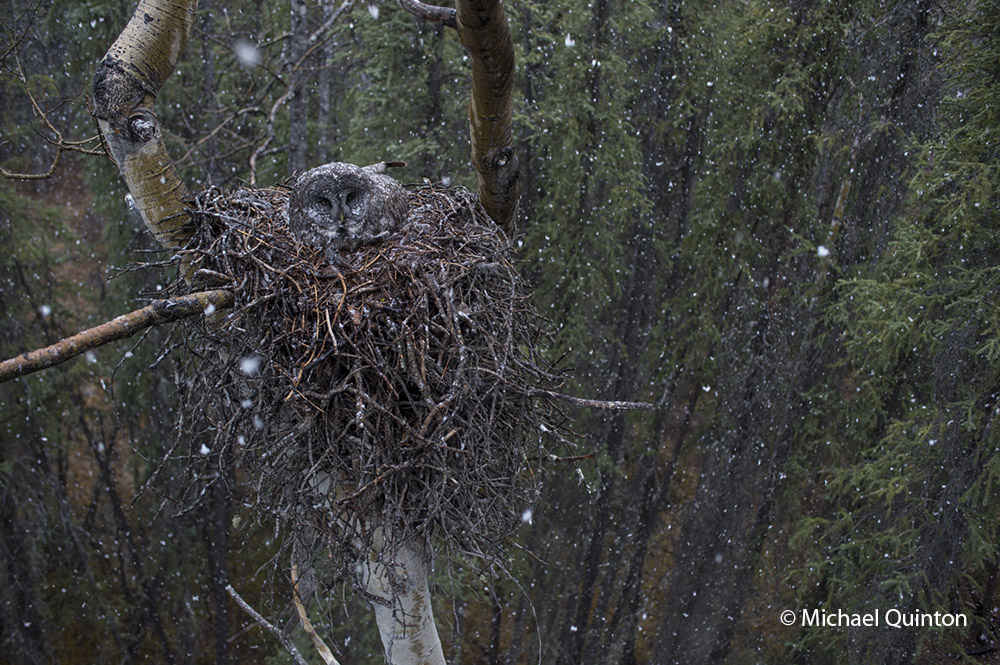 Eggs laid in the third week of April must be protected from the weather, as incubation begins with the first egg. The female does all the incubating and will sit on her eggs for thirty days.
Eggs laid in the third week of April must be protected from the weather, as incubation begins with the first egg. The female does all the incubating and will sit on her eggs for thirty days.
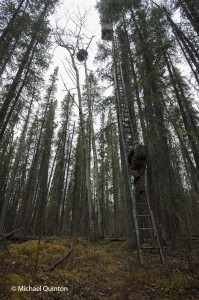 To gain access to the nesting great grays, more than fifty feet above the forest floor, I scabbed two long extensions ladders together and added an additional extension using two by fours. I had located the nest thirteen years ago. The three-foot wide nest was built by northern goshawks in a towering quaking aspen. Every spring I’d hike to the remote nest site to check its status. Goshawks had used the nest only once during the last thirteen years.
To gain access to the nesting great grays, more than fifty feet above the forest floor, I scabbed two long extensions ladders together and added an additional extension using two by fours. I had located the nest thirteen years ago. The three-foot wide nest was built by northern goshawks in a towering quaking aspen. Every spring I’d hike to the remote nest site to check its status. Goshawks had used the nest only once during the last thirteen years.
From my self-imposed confinement in the lofty, swaying photo blind, I witnessed much more than just the daily activities of the great gray owls. The female owl and I watched red squirrels, that rarely seen red squirrel predator, the marten, groups of migrating caribou, and a variety of bird life. Early one morning, not long after arriving, a huffing grizzly bear sow and yearling cub who had caught my scent quickly moved off beneath the blind. Once a curious cow moose who could hear my camera clicking finally looked up.
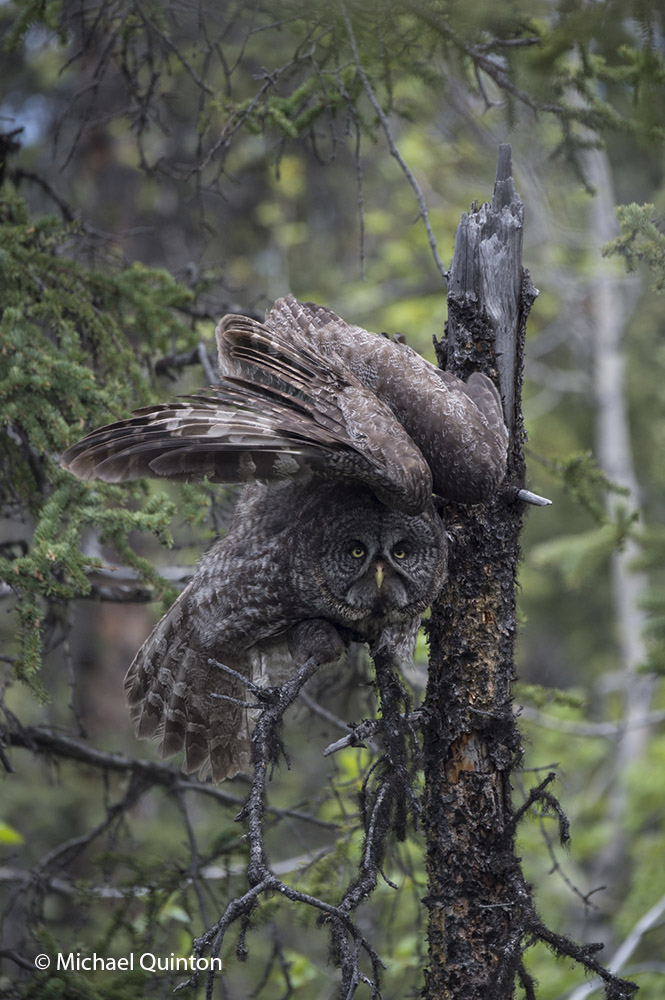 A couple of times a day the female flies off the nest to drink, cast her pellet and perhaps stretch before returning to her precious clutch of eggs.
A couple of times a day the female flies off the nest to drink, cast her pellet and perhaps stretch before returning to her precious clutch of eggs.
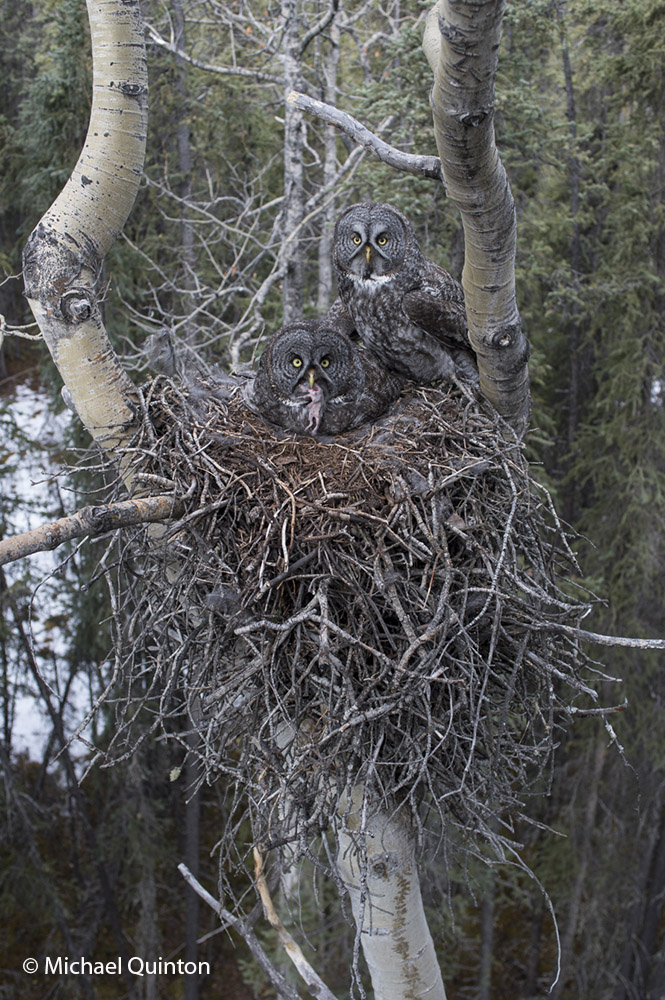 The male hunts for his mate and has just arrived with prey, a baby red squirrel. The male, who hunts during the day using sight and sound, is an opportunist and preys on a variety of small birds and mammals. Red-backed voles are by far the most important prey but shrews, small birds, and young snowshoe hares are also prey. Adult red squirrels are usually too alert and quick to be given much attention by the hunting male. But young squirrels, probably raided from their grass and sphagnum nests, are regularly on the menu.
The male hunts for his mate and has just arrived with prey, a baby red squirrel. The male, who hunts during the day using sight and sound, is an opportunist and preys on a variety of small birds and mammals. Red-backed voles are by far the most important prey but shrews, small birds, and young snowshoe hares are also prey. Adult red squirrels are usually too alert and quick to be given much attention by the hunting male. But young squirrels, probably raided from their grass and sphagnum nests, are regularly on the menu.
 A ruffed grouse male moves slowly through thick cover as it feeds on buds, last years berries and new leaves.
A ruffed grouse male moves slowly through thick cover as it feeds on buds, last years berries and new leaves.
Interior Alaska is definitely spruce grouse country. But along creeks and river bottoms, in old burns, in fact almost anywhere where several species of trees grow in thickets, narrow veins of ruffed grouse habitat can be found. Along the Slana River not far from where it enters the still modest Copper River, aspen, poplar, birch, white and black spruce, alder and a jumble of willow species form thickets where the cryptic ruffed grouse lives. Rose and high bush cranberry in the understory provide year round food for the few grouse that survive there. Continue reading
Technically, spring has arrived in the Alaskan Interior, but winter is rather reluctant to let go. So for the past three years I have left home in the first week of April to see if spring is having any better luck taking hold along the coast-about a hundred miles away as the raven flies. I am not disappointed. Spring is in full swing. But the weather along the coast is, as usual wet and windy. So once again I settle into a familiar routine, hanging out in a sheltered bay where sea otters congregate during unsettled weather and indulging in the very enjoyable task of observing and photographing the gentle and photogenic sea otters. Continue reading
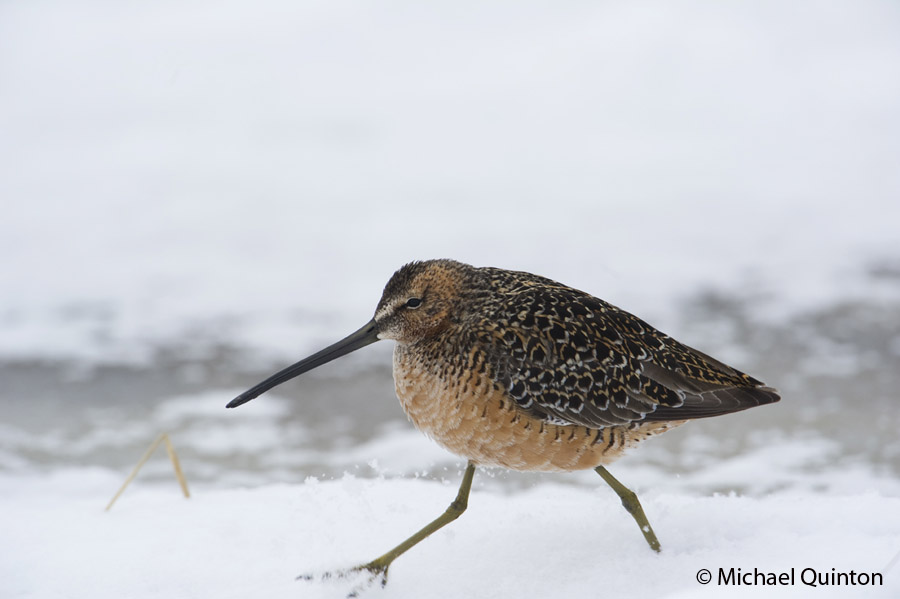 Long-billed dowitcher found interior Alaska still in the grip of winter.
Long-billed dowitcher found interior Alaska still in the grip of winter.
What a difference one year can make. This spring came earlier than normal to the Upper Copper River country in interior Alaska. It was warm and without our
usual spring snow storms. But last year, during the first week of May and at the peak of spring bird migration we were hard hit by a freak blast of winter weather. More than two feet of heavy snow fell over a period of several days covering everything including most sources of food for migrating birds. Continue reading
I got a tip a couple years ago about a lady who had complained about being kept awake at night because the snipes were making too much racket. But it had been too early in the season and I had a sneaky feeling it wasn’t snipes that were keeping her awake.
So, when I paid them a visit a couple weeks ago, I pulled out my I pod and speaker and asked if this is what she had heard. “Oh yes”, that’s it she insisted. “I could never forget that call. And they’re back! I have been hearing them again almost every night. ”
This was exciting news to me, because the call I had played was not the display flight of the common snipe. Instead I had played the territorial call of the boreal owl. She was quite surprised that it was a small owl she had been hearing. Continue reading